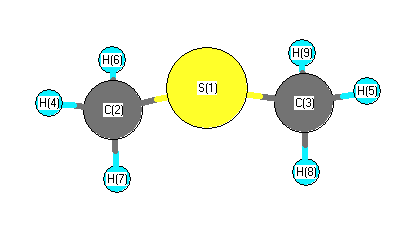Vibrational Frequencies calculated at QCISD(T)=FULL/cc-pVDZ
| Mode Number |
Symmetry |
Frequency
(cm-1) |
Scaled Frequency
(cm-1) |
IR Intensities
(km mol-1) |
Raman Act
(Å4/u) |
Dep P |
Dep U |
|---|
| 1 |
A1 |
3160 |
3030 |
|
|
|
|
| 2 |
A1 |
3044 |
2919 |
|
|
|
|
| 3 |
A1 |
1481 |
1420 |
|
|
|
|
| 4 |
A1 |
1362 |
1307 |
|
|
|
|
| 5 |
A1 |
1043 |
1000 |
|
|
|
|
| 6 |
A1 |
703 |
675 |
|
|
|
|
| 7 |
A1 |
265 |
254 |
|
|
|
|
| 8 |
A2 |
3139 |
3010 |
|
|
|
|
| 9 |
A2 |
1456 |
1396 |
|
|
|
|
| 10 |
A2 |
949 |
911 |
|
|
|
|
| 11 |
A2 |
176 |
169 |
|
|
|
|
| 12 |
B1 |
3132 |
3004 |
|
|
|
|
| 13 |
B1 |
1465 |
1405 |
|
|
|
|
| 14 |
B1 |
987 |
947 |
|
|
|
|
| 15 |
B1 |
186 |
179 |
|
|
|
|
| 16 |
B2 |
3160 |
3030 |
|
|
|
|
| 17 |
B2 |
3046 |
2921 |
|
|
|
|
| 18 |
B2 |
1473 |
1413 |
|
|
|
|
| 19 |
B2 |
1335 |
1280 |
|
|
|
|
| 20 |
B2 |
907 |
870 |
|
|
|
|
| 21 |
B2 |
756 |
725 |
|
|
|
|
Unscaled Zero Point Vibrational Energy (zpe) 16612.5 cm
-1
Scaled (by 0.959) Zero Point Vibrational Energy (zpe) 15931.4 cm
-1
See section
III.C.1 List or set vibrational scaling factors
to change the scale factors used here.
See section
III.C.2
Calculate a vibrational scaling factor for a given set of molecules
to determine the least squares best scaling factor.
